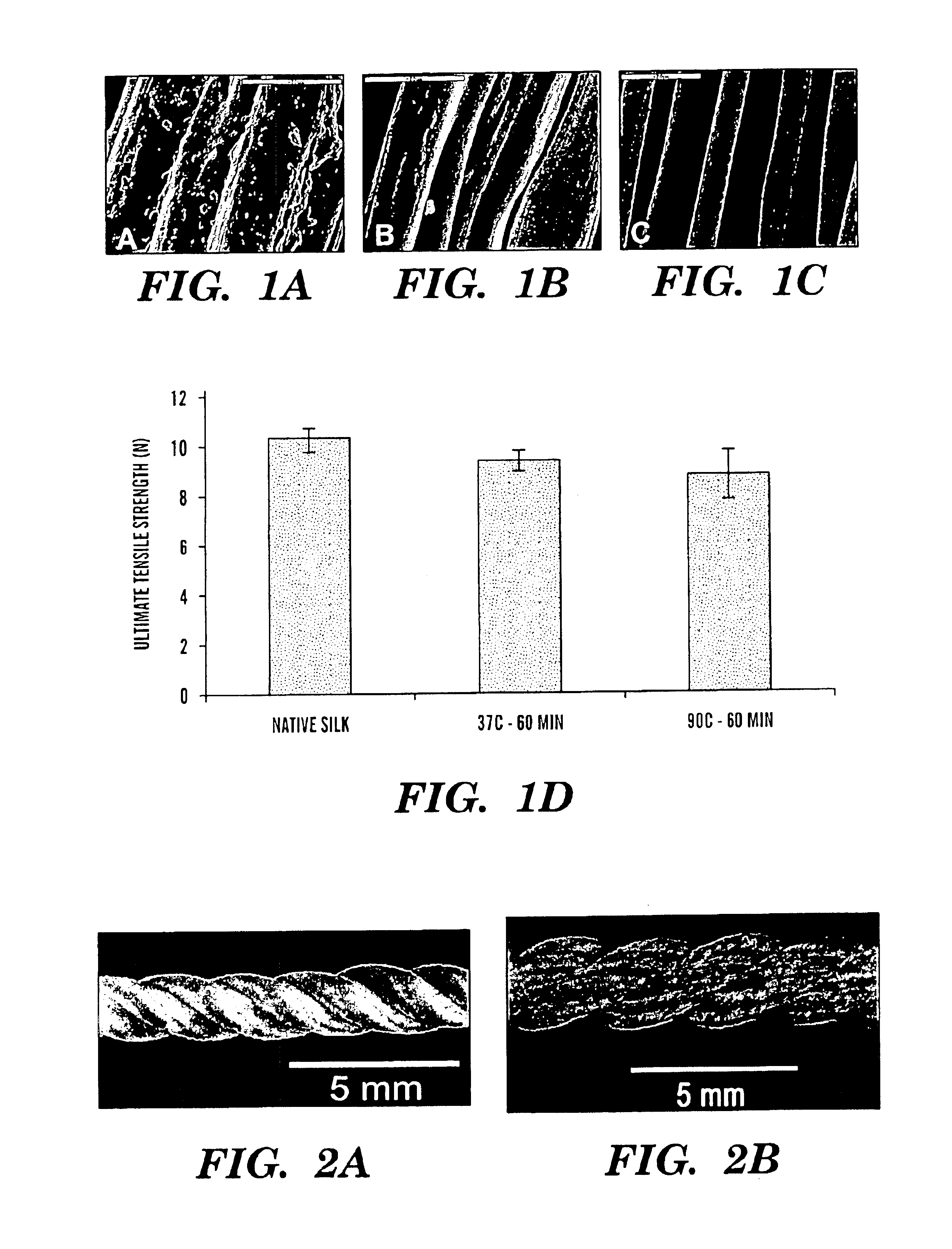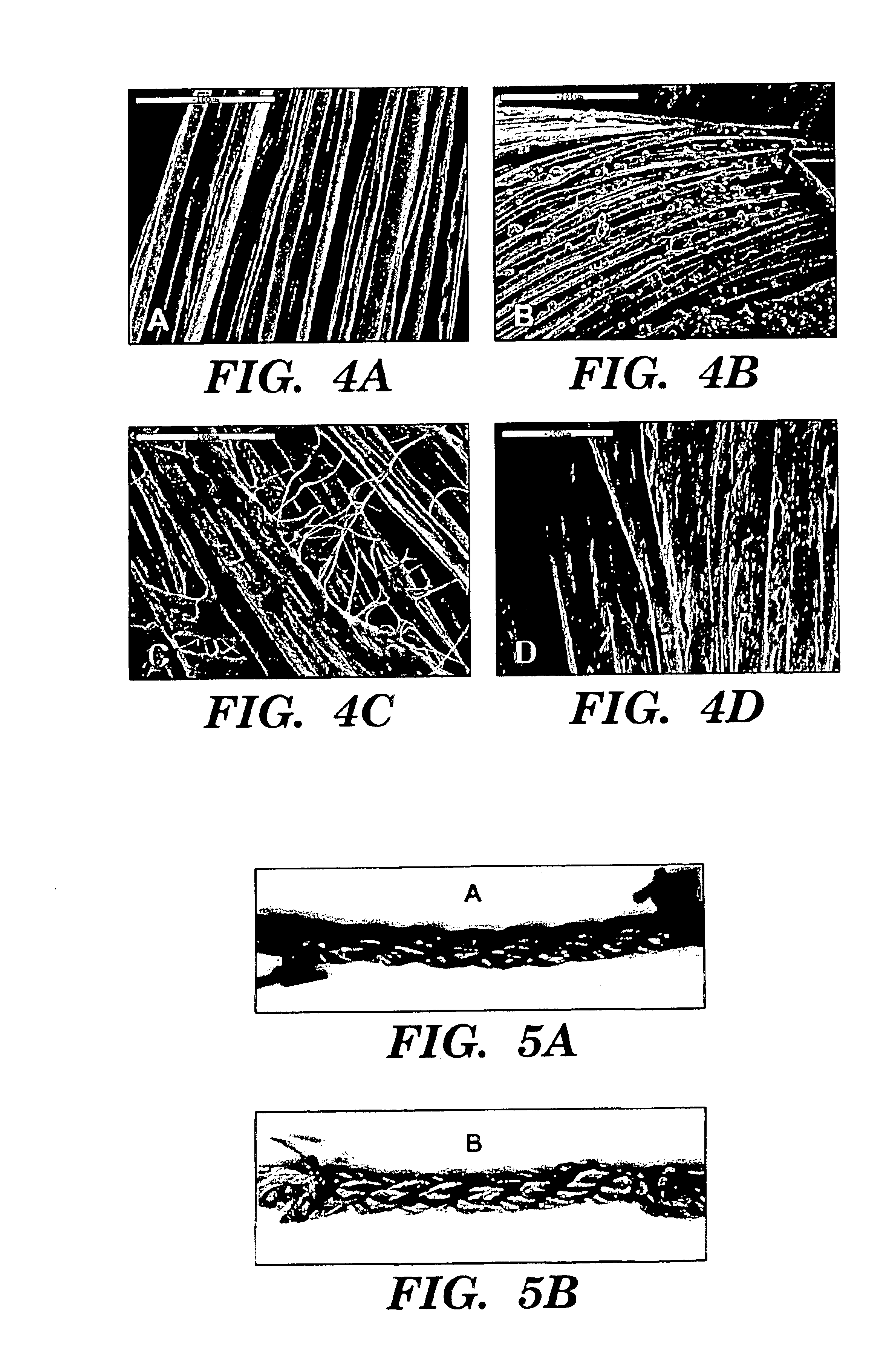Helically organized silk fibroin fiber bundles for matrices in tissue engineering
a tissue engineering and bundle technology, applied in the field of matrix or scaffold, can solve the problems of severe limitations in mobility, pain and discomfort, loss of the ability to participate in sports and exercise, etc., and achieve the effect of enhancing the differentiation and tissue development process
- Summary
- Abstract
- Description
- Claims
- Application Information
AI Technical Summary
Benefits of technology
Problems solved by technology
Method used
Image
Examples
example 1
a. Preparation of Silk Films
[0090]Raw Bombyx mori silkworm fibers, shown in FIG. 1A, were extracted to remove sericin, the glue-like protein coating the native silk fibroin (see FIGS. 1A-C). The appropriate number of fibers per group were arranged in parallel and extracted in an aqueous solution of 0.02M Na2CO3 and 0.3% (w / v) Ivory soap solution for 60 min at 90° C., then rinsed thoroughly with water to extract the glue-like sericin proteins.
b. Preparation of and Properties of the Silk-Fiber Based Matrix Construct
[0091]Costello's equation for a three-strand wire rope was derived to predict mechanical properties of the silk-fiber-based matrix. The derived model is a series of equations that when combined, take into account extracted silk fiber material properties and desired matrix geometrical hierarchy to compute the overall strength and stiffness of the matrix as a function of pitch angle for a given level of geometrical hierarchy The material properties of a single silk fiber incl...
example 2
Cell Isolation and Culture
[0098]Bone Marrow Stromal Cells (BMSC), pluripotent cells capable of differentiating into osteogenic, chondrogenic, tendonogenic, adipogenic and myogenic lineages, were chosen since the formation of the appropriate conditions can direct their differentiation into the desired ligament fibroblast cell line (Markolf et al., J. Bone Joint Surg. 71A: 887-893 (1989); Caplan et al., Mesenchymal stem cells and tissue repair. In The Anterior Cruciate Ligament: Current and Future Concepts, Ed. D. W. Jackson et al., Raven Press, Ltd, New York (1993); Young et al., J. Orthopaedic Res. 16: 406-413 (1998)).
[0099]Human BMSCs were isolated from bone marrow from the iliac crest of consenting donors ≦25 years of age by a commercial vendor (Cambrex, Walkersville, Md.). Twenty-two milliliters of human marrow was aseptically aspirated into a 25 ml syringe containing three milliliters of heparinized (1000 units per milliliter) saline is solution. The heparinized marrow solution ...
example 3
[0105]Studies are conducted to provide insight into the influence of directed multi-dimensional mechanical stimulation on ligament formation from bone marrow stromal cells in the bioreactor system. The bioreactor is capable of applying independent but concurrent cyclic multi-dimensional strains (e.g., translation, rotation) to the developing ligaments. After a 7 to 14 day static rest period (time post seeding), the rotational and translation strain rates and linear and rotational deformation are kept constant for 1 to 4 weeks. Translational strain (3.3%-10%, 1-3 mm) and rotational strain (25%, 90°) are concurrently applied at a frequency of 0.0167 Hz (one full cycle of stress and relaxation per minute) to the silk-based matrices seeded with BMSCs; an otherwise identical set of bioreactors with seeded matrices without mechanical loading serve as controls. The ligaments are exposed to the constant cyclic strains for the duration of the experiment days.
[0106]Following the culture perio...
PUM
| Property | Measurement | Unit |
|---|---|---|
| length | aaaaa | aaaaa |
| length | aaaaa | aaaaa |
| diameter | aaaaa | aaaaa |
Abstract
Description
Claims
Application Information
 Login to View More
Login to View More - R&D
- Intellectual Property
- Life Sciences
- Materials
- Tech Scout
- Unparalleled Data Quality
- Higher Quality Content
- 60% Fewer Hallucinations
Browse by: Latest US Patents, China's latest patents, Technical Efficacy Thesaurus, Application Domain, Technology Topic, Popular Technical Reports.
© 2025 PatSnap. All rights reserved.Legal|Privacy policy|Modern Slavery Act Transparency Statement|Sitemap|About US| Contact US: help@patsnap.com



